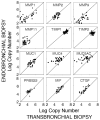Transcript signatures of lymphocytic bronchitis in lung allograft biopsy specimens
- PMID: 16102441
- PMCID: PMC2271113
- DOI: 10.1016/j.healun.2004.06.016
Transcript signatures of lymphocytic bronchitis in lung allograft biopsy specimens
Abstract
Background: Rejection and obliterative bronchiolitis are barriers to sustained graft function in recipients of transplanted lungs. Early detection is hindered by inadequate tests and an incomplete understanding of the molecular events preceding or accompanying graft deterioration.
Methods: Hypothesizing that genes involved in immune responses and tissue remodeling produce biomarkers of rejection, we measured the expression of 192 selected genes in 72 sets of biopsy specimens from human lung allografts. Gene transcripts were quantified using a 2-step, multiplex, real-time polymerase chain reaction approach in endobronchial and transbronchial biopsy specimens from transplant recipients without acute infections undergoing routine surveillance bronchoscopy.
Results: Comparisons of histopathology in parallel biopsy specimens identified 6 genes correlating with rejection as manifested by lymphocytic bronchitis, a suspected harbinger of obliterative bronchiolitis. For example, beta2-defensin and collagenase transcripts in inflamed bronchi increased 37-fold and 163-fold, respectively. By contrast, these transcripts did not correlate with acute rejection in transbronchial specimens. Further, no correspondence was noted between histopathologic bronchitis and parenchymal rejection when endobronchial and transbronchial samples were obtained from the same patient.
Conclusions: Our highly sensitive method permits quantitation of many gene transcripts simultaneously in small, bronchoscopically acquired biopsy specimens of allografts. Transcript signatures obtained by this approach suggest that airway and alveolar responses to rejection differ and that endobronchial biopsy specimens assess lymphocytic bronchitis and chronic rejection but are not proxies for transbronchial biopsy specimens. Further, they reveal changes in airway expression of the specific genes involved in host defense and remodeling and suggest that the measurement of transcripts correlating with lymphocytic bronchitis may be diagnostic adjuncts to histopathology.
Figures


Similar articles
-
Association of large-airway lymphocytic bronchitis with bronchiolitis obliterans syndrome.Am J Respir Crit Care Med. 2013 Feb 15;187(4):417-23. doi: 10.1164/rccm.201206-1025OC. Epub 2012 Dec 13. Am J Respir Crit Care Med. 2013. PMID: 23239157 Free PMC article.
-
Yield of surveillance bronchoscopy for acute rejection and lymphocytic bronchitis/bronchiolitis after lung transplantation.J Heart Lung Transplant. 2004 Dec;23(12):1396-404. doi: 10.1016/j.healun.2003.09.018. J Heart Lung Transplant. 2004. PMID: 15607670
-
"Refractoriness" of airflow obstruction associated with isolated lymphocytic bronchiolitis/bronchitis in pulmonary allografts.J Heart Lung Transplant. 1997 Aug;16(8):832-8. J Heart Lung Transplant. 1997. PMID: 9286775
-
The role of bronchoscopic surveillance monitoring in the care of lung transplant recipients.Semin Respir Crit Care Med. 2006 Oct;27(5):480-91. doi: 10.1055/s-2006-954606. Semin Respir Crit Care Med. 2006. PMID: 17072796 Review.
-
Bronchoalveolar lavage in lung transplantation. State of the art.Clin Transplant. 1999 Apr;13(2):131-57. doi: 10.1034/j.1399-0012.1999.130201.x. Clin Transplant. 1999. PMID: 10202611 Review.
Cited by
-
Tissue inhibitor of metalloproteinase-1 moderates airway re-epithelialization by regulating matrilysin activity.Am J Pathol. 2008 May;172(5):1256-70. doi: 10.2353/ajpath.2008.070891. Epub 2008 Apr 1. Am J Pathol. 2008. PMID: 18385523 Free PMC article.
-
Gene expression profiling in organ transplantation.Int J Nephrol. 2011;2011:180201. doi: 10.4061/2011/180201. Epub 2011 Aug 9. Int J Nephrol. 2011. PMID: 21845224 Free PMC article.
-
Acute allograft rejection: cellular and humoral processes.Clin Chest Med. 2011 Jun;32(2):295-310. doi: 10.1016/j.ccm.2011.02.008. Epub 2011 Mar 25. Clin Chest Med. 2011. PMID: 21511091 Free PMC article.
-
Association of large-airway lymphocytic bronchitis with bronchiolitis obliterans syndrome.Am J Respir Crit Care Med. 2013 Feb 15;187(4):417-23. doi: 10.1164/rccm.201206-1025OC. Epub 2012 Dec 13. Am J Respir Crit Care Med. 2013. PMID: 23239157 Free PMC article.
-
Acute rejection and humoral sensitization in lung transplant recipients.Proc Am Thorac Soc. 2009 Jan 15;6(1):54-65. doi: 10.1513/pats.200808-080GO. Proc Am Thorac Soc. 2009. PMID: 19131531 Free PMC article. Review.
References
-
- Stewart KC, Patterson GA. Current trends in lung transplantation. Am J Transplant. 2001;1:204–10. - PubMed
-
- DeMeo DL, Ginns LC. Lung transplantation at the turn of the century. Annu Rev Med. 2001;52:185–201. - PubMed
-
- Reichart B, Gulbins H, Meiser BM, Kur F, Briegel J, Reichenspurner H. Improved results after heart–lung transplantation: a 17-year experience. Transplantation. 2003;75:127–32. - PubMed
-
- Reichenspurner H, Girgis RE, Robbins RC, et al. Obliterative bronchiolitis after lung and heart-lung transplantation. Ann Thorac Surg. 1995;60:1845–53. - PubMed
-
- Husain AN, Siddiqui MT, Holmes EW, et al. Analysis of risk factors for the development of bronchiolitis obliterans syndrome. Am J Respir Crit Care Med. 1999;159:829–33. - PubMed
Publication types
MeSH terms
Substances
Grants and funding
LinkOut - more resources
Full Text Sources
Medical

